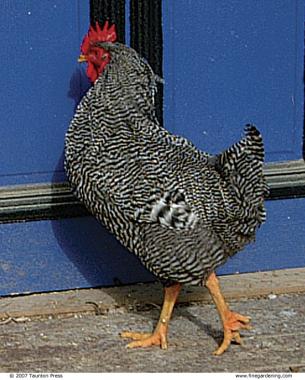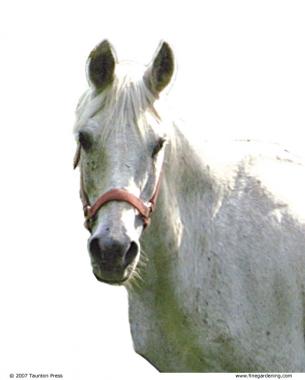How to Top Dress Garden With Compost Black Hen Manure
While there are many innovations that make life easier or get the job done faster, sometimes nothing beats the old-fashioned way. At least that's how many gardeners feel when it comes to fertilizing their garden. Who needs a flashy package of tiny granules when you can feed your plants with manure? Pound for pound, the nutrient content of manure may be lower than most synthetic fertilizers; manure, however, provides the carbon compounds (organic materials) that build soil structure—something synthetic fertilizers cannot do.
Unless you have a manure tested, there's no way of knowing for sure what its nutrient content is. Many factors influence the varying nutrient content of manures, including the type and age of the animal, the food eaten by the animal, the manure's moisture content, the amount of bedding mixed in, the way the manure has been handled or stored, and its age. Studies have been done, however, that give a general idea of the amount of nutrients you can expect from various types of manures.
Always use composted manure
Unless you are starting a new bed that you don't plan to plant for some time, it's best to use composted manure in the garden. Fresh or raw manures are more concentrated in nutrients and will burn your plants. Sheep and especially poultry manure are considered "hot" and may burn seedlings and transplants, inhibit seed germination, or make your perennials grow so fast and thin that they fall over.
Furthermore, raw manure can have an offensive odor, attract flies, and be difficult to transport. Worst of all, it contains pathogens that might make you sick and weed seeds that will spread to your garden. That last point alone sells me on composted manure since the last thing I want to do is pull more weeds.
If you do decide to apply raw manure, do not use it for surface applications or topdressing in already vegetated areas. The high nutrient content may damage your plants. Instead, dilute the manure with soil and hasten the decomposition process by incorporating the manure into the soil surface before the area is planted. Do this in early fall to give the manure time to break down before you plant in the spring. It's also a good idea to cover the tilled area with mulch or leaves to protect the surface from erosion or throw on some winter rye seed for a cover crop.
Avoid applying manure on areas next to streams or riverbanks. It is important to keep the nutrients and pathogens in the manure away from surface waters. To protect yourself, raw manure should never be used in the vegetable garden and you should always wash your hands thoroughly after working with manure. While the chances of infection from diseases like salmonella (from poultry manure) are not huge, it's always better to be safe than sorry.
Nutrient content of manure

According to a study conducted at Pennsylvania State University, here are the average percentages of nitrogen, phosphorus, and potassium (N-P-K) commonly found in animal manures. These percentages may not seem like a lot, but they have an impact—and a little bit goes a long way.
| Manure | N | P | K |
| Poultry | 1.8 | 2.7 | 1.5 |
| Dairy cattle | 0.5 | 0.2 | 0.4 |
| Beef cattle | 0.5 | 0.3 | 0.5 |
| Swine | 0.3 | 0.4 | 0.2 |
| Sheep | 1.1 | 0.4 | 1.0 |
| Horse | 0.6 | 0.2 | 0.4 |
Look for manure locally

The type of manure you can get depends on where you live, since farms differ around the country. If you have a choice, cow or horse manure is good if you are looking for a manure with organic matter. Both animals eat grass and produce a nice carbon-rich manure. Sheep manure is equally good for the same reason, plus it comes in a naturally small package, which makes it easier to handle. Swine manure has the lowest nitrogen content, so consider it for situations in which you need to build up phosphorus and potassium levels. In contrast, poultry manure has the highest nitrogen concentration.
Acquiring manure from a local farmer is usually easy. Most farmers are happy to give manure away. If you've never met your farm neighbors before, call them on the phone or stop by to introduce yourself. Many farmers welcome the chance to explain how things work on their farm so that their neighbors will be more understanding when it comes to seasonal operations, which may be noisy or smelly. Some farms produce and bag their own composted manure for sale. I find that purchasing locally produced composted manure is a great way to support area farmers.
If you don't live near a farm that sells composted manure, you can usually find it at garden centers and retail stores. Look for a product that lists the nutrient content on the bag so that you know what you are getting. The type of manure from which the compost is made (from livestock, zoo animals, and, yes, even crickets) is not as important as the quality of the finished product. Mature, stable, composted manure will have a relatively uniform granular appearance and will not feel warm to the touch.
Turn brown dung into black gold
If you end up finding a source of raw manure, it's fairly easy to compost it yourself. The same principles apply to composting manure as to any other organic material.
1. Start with a balanced mix
Simply mix equal parts of "something green" (like grass clippings and food waste) and "something brown" (like leaves and straw). Fresh manure falls into the "something green" category, unless it is already mixed with a lot of barn straw or sawdust. In the latter case, you won't need to add as much of "something brown." With trial and error, you will eventually discover the best proportions for your material.
2. Add water and air
A good compost pile has enough moisture to keep the microbes alive while still allowing air to penetrate the pile. It takes a good six to nine months to compost manure, depending on whether you are managing the pile actively (turning the pile periodically) or passively.
3. Use it wisely
Remember to use soil amendments responsibly and have your soil tested annually to be sure you are not applying more nutrients than your plants need. Excess nutrients, whether in the form of synthetic fertilizer or composted manure, can run off or leach into the environment and contaminate streams, lakes, and wells.
How to Top Dress Garden With Compost Black Hen Manure
Source: https://www.finegardening.com/project-guides/gardening-basics/fertilizing-the-old-fashioned-way-with-manure
0 Response to "How to Top Dress Garden With Compost Black Hen Manure"
Post a Comment